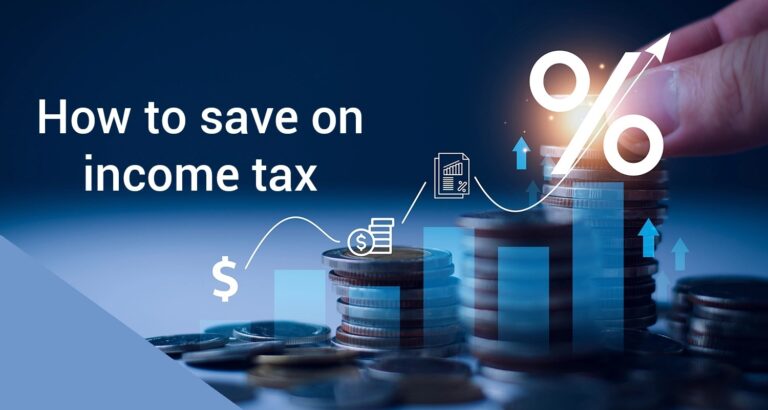Income tax is an unavoidable responsibility for every working individual in India. However, the good news is that the Income Tax Act provides several legal ways to save on taxes through deductions, exemptions, and rebates. With smart planning and awareness of available tax-saving instruments, you can significantly reduce your tax liability while growing your wealth.
Whether you’re a salaried employee, a freelancer, or a business owner, this guide will walk you through effective, legal, and government-approved strategies to save income tax in India.
1. Understanding Tax Slabs in India
Before diving into tax-saving strategies, it’s important to understand the income tax slabs applicable under the old and new tax regimes.
Old Regime (FY 2024–25)
| Income Slab (in ₹) | Tax Rate |
| Up to 2.5 lakh | Nil |
| 2.5 – 5 lakh | 5% |
| 5 – 10 lakh | 20% |
| Above 10 lakh | 30% |
Additional cess of 4% applies on total tax.
New Regime (Optional)
The new tax regime offers lower tax rates but without most exemptions and deductions.
Taxpayers can choose between the old and new regimes based on what suits them best. For most people who make full use of deductions, the old regime tends to be more beneficial.
2. Top Legal Ways to Save Tax in India
Let’s explore the most effective ways to save income tax legally:
a. Section 80C – Investments up to ₹1.5 Lakh
Under Section 80C, you can claim deductions up to ₹1.5 lakh per year. Some common eligible instruments include:
- Employee Provident Fund (EPF)
- Public Provident Fund (PPF)
- Equity Linked Saving Scheme (ELSS)
- Life Insurance Premiums
- National Savings Certificate (NSC)
- 5-Year Fixed Deposit with Banks
- Tuition fees for children
- Principal repayment on home loan
Smart tip: ELSS offers tax benefits and higher returns due to its equity exposure.
b. Section 80D – Health Insurance Premium
Premiums paid for health insurance qualify for deductions under Section 80D:
- Up to ₹25,000 for self, spouse, and children
- Additional ₹25,000 for parents (below 60)
- ₹50,000 for senior citizen parents
If both you and your parents are senior citizens, you can claim up to ₹1,00,000!
c. House Rent Allowance (HRA)
If you live in a rented house and receive HRA as part of your salary, you can claim a deduction under the following conditions:
- Rent must be paid
- You should not own a house in the same city
Amount of exemption is the least of:
- Actual HRA received
- 50% of salary (metro cities) or 40% (non-metros)
- Rent paid – 10% of salary
d. Standard Deduction for Salaried Individuals
Salaried employees and pensioners can avail a standard deduction of ₹50,000 without needing to show any bills or receipts. It’s a flat deduction that reduces your taxable income.
e. National Pension System (NPS) – Extra ₹50,000
Contributions to NPS qualify for:
- ₹1.5 lakh under Section 80C
- Additional ₹50,000 under Section 80CCD(1B)
This is a great option for retirement planning and saving additional tax beyond the 80C limit.
f. Home Loan – Interest and Principal Deduction
Buying a home comes with tax benefits:
- Principal repayment: ₹1.5 lakh under Section 80C
- Interest on home loan: Up to ₹2 lakh under Section 24(b)
- First-time homebuyers may also claim additional ₹50,000 under Section 80EE
g. Education Loan – Section 80E
If you’ve taken a loan for higher education (yourself, spouse, or children), you can claim a deduction on interest paid under Section 80E for up to 8 years.
h. Leave Travel Allowance (LTA)
Employees can claim LTA for travel within India, twice in a block of 4 years. Only actual travel costs (by air, rail, or bus) are allowed, and proof of travel is needed.
i. Other Deductions
- Section 80G: Donations to eligible charities (50% or 100% deductible)
- Section 80GG: For those who don’t receive HRA but pay rent
- Section 80TTB: Interest income for senior citizens (up to ₹50,000)
3. Tax-Saving Tips for Salaried Individuals
If you’re a salaried professional, here are some tax-saving hacks:
- Opt for meal coupons (tax-free up to ₹2,200/month)
- Use reimbursement components like phone, internet, books
- Choose company-leased car if your employer offers it
- Invest in tax-saving mutual funds (ELSS) early in the year
- Don’t wait till March—plan your 80C investments monthly
4. Tax-Saving Tips for Freelancers & Business Owners
Freelancers and business owners can also benefit from these strategies:
- Show business expenses like rent, electricity, software, travel, etc.
- Use Section 44ADA (presumptive taxation) if you’re a professional
- Invest in NPS and ELSS for long-term savings
- Buy health insurance and claim under 80D
- Pay rent and claim deduction under 80GG if not receiving HRA
Maintain proper books of accounts and hire a CA if needed to optimize deductions.
5. Final Thoughts
Paying taxes is a civic duty, but there’s no reason to pay more than required. India’s Income Tax Act offers multiple ways to reduce your taxable income legally. By making informed decisions and using available deductions and exemptions, you can significantly reduce your tax outgo and secure your financial future.
Quick Recap of Key Tax-Saving Tools:
| Section | Purpose | Max Deduction |
| 80C | Investments, insurance, tuition | ₹1.5 lakh |
| 80CCD(1B) | NPS (additional) | ₹50,000 |
| 80D | Health insurance | ₹1 lakh |
| 24(b) | Home loan interest | ₹2 lakh |
| 80E | Education loan interest | No limit |
| 80G | Donations | Varies |
| Standard Deduction | Salaried/pensioners | ₹50,000 |
Start early, keep records, and consult a tax advisor if needed. With the right strategy, you can reduce your tax burden and achieve your financial goals more efficiently.


Average Rating